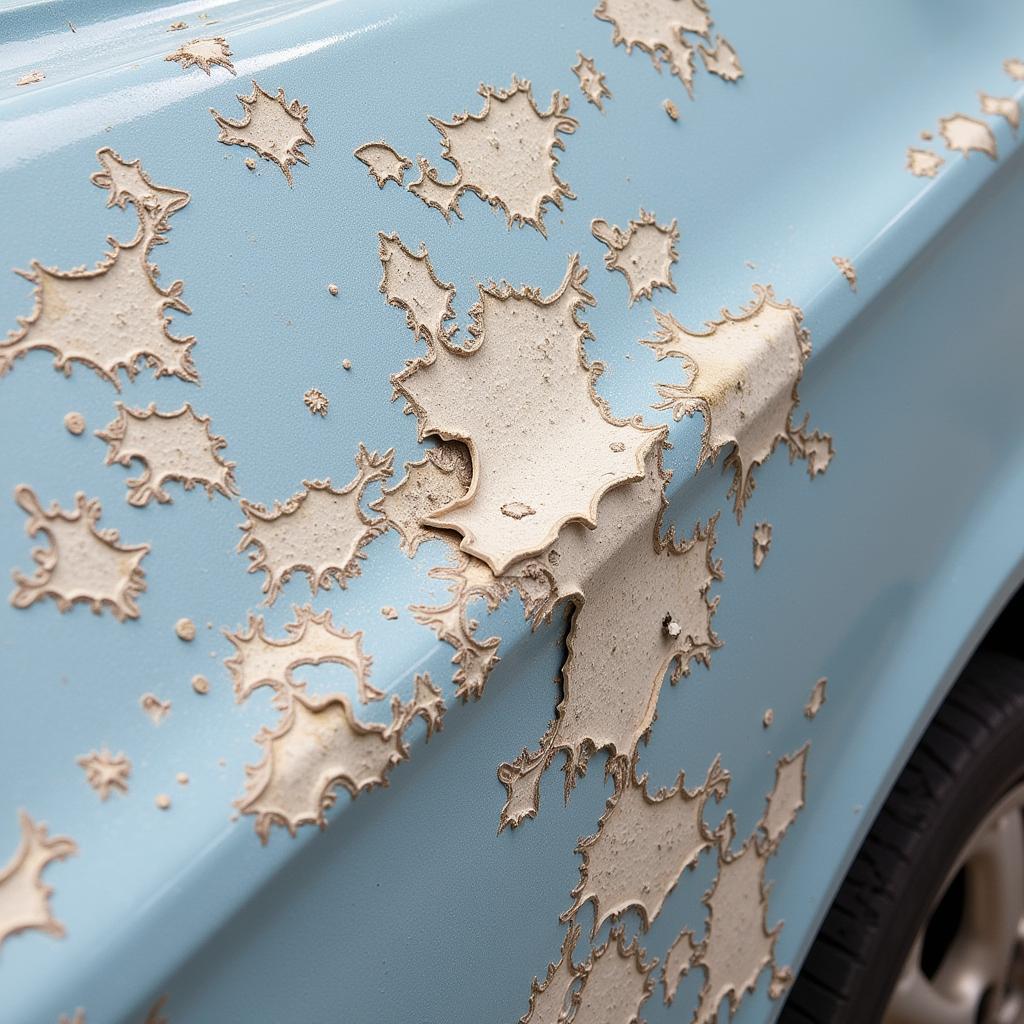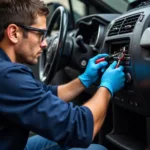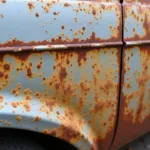Peeling car paint is an eyesore that can significantly detract from your vehicle’s aesthetic appeal and even decrease its resale value. This comprehensive guide will walk you through the steps of repairing peeling paint, from identifying the root cause to achieving a professional-looking finish.
Understanding the Causes of Peeling Paint
Before diving into the repair process, it’s crucial to understand what causes car paint to peel in the first place. Common culprits include:
- UV Damage: Prolonged exposure to the sun’s ultraviolet rays can degrade the paint’s protective clear coat, leading to fading, cracking, and eventually, peeling.
- Oxidation: When paint is exposed to oxygen and moisture, a chemical reaction known as oxidation occurs. This causes the paint to lose its luster and become chalky, eventually leading to peeling.
- Improper Washing Techniques: Using harsh detergents, abrasive cleaning tools, or even automatic car washes with rotating brushes can gradually wear down the paint’s protective layers, making it susceptible to peeling.
- Poor-Quality Paint Jobs: If your car was repainted in the past and the job was poorly executed, the new paint may not have adhered properly to the underlying layers, resulting in peeling over time.
- Environmental Factors: Living in coastal areas with salty air, areas with harsh winters and road salt, or regions with high levels of air pollution can accelerate paint damage and peeling.
 Car Paint Peeling Causes
Car Paint Peeling Causes
Assessing the Damage
The first step in repairing peeling paint is to assess the severity of the damage.
- Minor Peeling: If the peeling is confined to a small area and the affected layers are superficial, a simple touch-up might suffice.
- Moderate Peeling: When peeling affects a larger area or involves multiple layers of paint, you’ll need to sand down the affected area and repaint.
- Severe Peeling: Extensive peeling that exposes bare metal requires more extensive repairs, including rust removal and potentially the help of a professional.
DIY Repair for Minor Peeling Paint
Tools and Materials:
- Car wash soap
- Microfiber wash mitt
- Automotive masking tape
- 220-grit sandpaper
- 400-grit sandpaper
- Primer (if necessary)
- Touch-up paint (matching your car’s color code)
- Clear coat
- Foam applicator pads
Instructions:
- Wash and Dry: Thoroughly wash and dry the affected area to remove dirt, grime, and loose paint chips.
- Mask Off: Use automotive masking tape to protect the surrounding areas of good paint.
- Sand the Area: Gently sand the peeling paint edges with 220-grit sandpaper. Feather the edges outward to create a smooth transition.
- Clean the Surface: Wipe away sanding dust with a clean, damp cloth.
- Prime (If Necessary): If you’ve sanded down to bare metal, apply a thin coat of primer to promote paint adhesion. Allow it to dry completely.
- Apply Touch-Up Paint: Using a fine-tip brush or a touch-up pen, carefully apply thin coats of touch-up paint to the affected area. Allow each coat to dry completely before applying the next.
- Sand and Buff (Optional): Once the paint is dry, you can use 400-grit sandpaper to lightly sand the area for a smooth finish. Follow up with buffing compound for added shine.
Seeking Professional Help
While minor peeling paint can often be addressed with DIY repairs, more extensive damage is best handled by a professional auto body shop. Repair car paint peeling can be a complex process, and professional technicians have the expertise, tools, and experience to ensure a seamless and long-lasting repair.
Here are some situations where seeking professional help is recommended:
- Extensive Peeling: If the peeling paint covers a large surface area or exposes a significant amount of bare metal, it’s best left to the professionals.
- Rust Damage: Peeling paint often goes hand-in-hand with rust. If you notice any signs of rust, seeking professional help is crucial to prevent further damage.
- Matching Paint Color: Achieving a perfect color match when repainting can be challenging. Professional auto body shops have color-matching technology to ensure the new paint blends seamlessly with your car’s existing finish.
Preventing Future Peeling
Preventing paint peeling is always preferable to dealing with repairs. Here are some proactive steps you can take:
- Regular Washing: Wash your car regularly using a pH-neutral car wash soap and a microfiber wash mitt. Avoid harsh detergents and abrasive cleaning tools.
- Waxing: Applying a coat of wax every few months creates a protective barrier against UV rays, oxidation, and other environmental contaminants.
- Covered Parking: Whenever possible, park your car in a garage or under a carport to shield it from direct sunlight and weather elements.
- Prompt Repairs: Address minor paint chips and scratches promptly to prevent them from spreading and leading to more significant peeling issues.
Conclusion
Peeling car paint can be frustrating, but understanding the causes and taking the appropriate steps can help you restore your vehicle’s appearance. While minor peeling can be tackled with DIY repairs, don’t hesitate to seek professional help for more extensive damage. Remember, how to repair peeling car paint involves understanding the root cause and taking appropriate action to prevent future issues. By following the tips outlined in this guide, you can keep your car looking its best for years to come.


